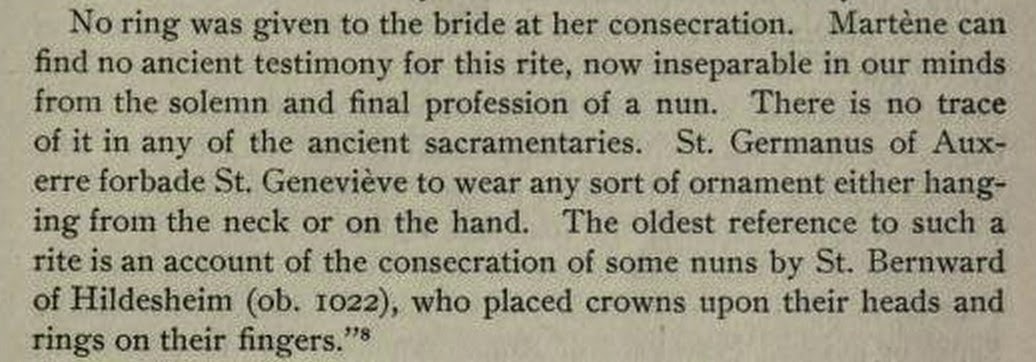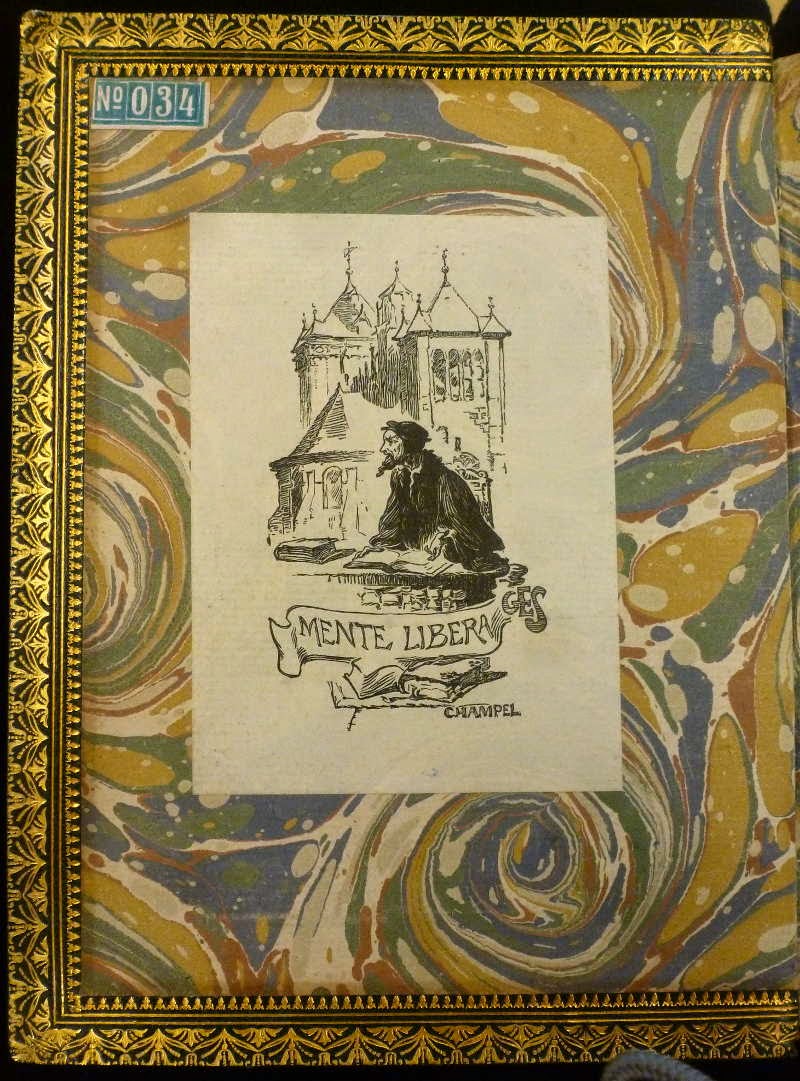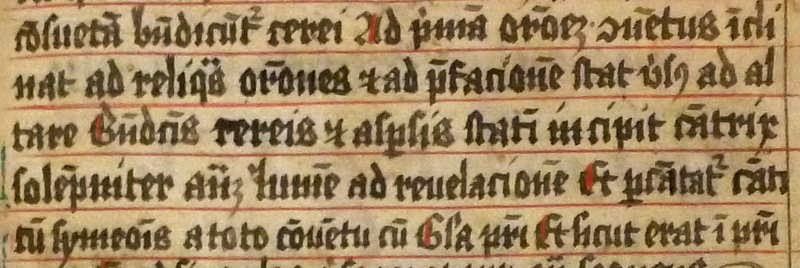But before turning to its origin, what can we tell about its more recent provenance?
Stuck to the front pastedown is a bookplate with an image of a scholar in front of a church, with "MENTE LIBERA", "GES" and "CHAMPEL":
A web search quickly finds the same bookplate in a book at Penn, where it is identified as the:
"Bookplate of Gaspard Ernest Stroehlin (1844–1907) a Swiss minister and professor (specializing in church history) at the University of Geneva. "Mente libera" was his motto; "Champel" appears to be an allusion to Champel, Switzerland, where the reformer Michael Servetus was burned at the stake in 1553. The building in the background is probably St. Pierre Cathedral in Geneva, where Calvin famously preached"The online description continues:
"Hans Asper bound several of Stroehlin's books; cf. I. Krekler, Stammbücher bis 1625 (Wiesbaden: Harassowitz, 1999), p. 6 (nr. 2)."and indeed the present volume has the ink stamp of Hans Asper:
In due course I hope find out what that red "5" refers to, as well as the "No.034" paper label on the pastedown:
The contents of the volume is in two main parts, the first part a Processional. The text begins with the chants for the procession on the feast of the Purification of the Virgin (or Candlemas, 2 Feburary):
The rubric at the top mentions a "conventus" (line 3, 1st word; cf. line 7) and a "cantrix" (line 5, last word), giving a clue as to whom this book was made, a female convent:
The rubrics give a good sense of the contents of the Processional part of the volume (I have put some significant ones in bold):
- (fol.1r) "In purificatione beate Marie virginis"
- (fol.5v) "In die palmarum"
- (fol.15r) "In cena domini qunado lavantur altaria. Primo ad summum altare"
- (fol.15v) "Deinde de sancto Iacobo"
- (fol.16v) "Deinde ad altare sancte crucis"
- (fol.19r) "Deinde de sancta Elyzabeth"
- (fol.19r) "Deinde ad altare sancti Augustini"
- (fol.20r) "Deinde de sancta Maria Magdalena"
- (fol.20v) "Deinde ad altare sancti Christofore"
- (fol.21r) "Deinde de sancto Stephano"
- (fol.21v) "Deinde ad altare sancti Iohannis Baptiste"
- (fol.22r) "Deinde de sancto Iohanne Ewangelista"
- (fol.22v) "Deinde ad altare sancte Marie virginis"
- (fol.23r) "Deinde de sancta Anna"
- (fol.23v) "Deinde ad altare sancti Berwardi [sic] episcopi"
- (fol.24r) "Deinde de sancto Luca"
- (fol.24v) "Deinde de sancta Katherina"
- (fol.25r) "Deinde de omnibus sanctis"
- (fol.36r) "In vigilia pasche post benedictionem ignis"
- (fol.38v) "Letanie in vigilia pasche"
- (fol.43v) "In die sancto pasche, assencionis, et pentecosten ad processionem"
- (fol.45v) "Ymnus In die pasche et ceteris diebus"
- (fol.49r) "Feria secunda, tercia et quarta in rogationibus, Et in die marti ad aspersionem aque benedicte"
- (fol.52v) "In vigilia penthecostes"
- (fol.55r) "In die sacramenti ad processionem"
- (fol.56v) "In die assumcionis beate Marie ad processionem"
- (fol.59r) "In dedicacione ecclesie ad processionem"
The mention of an altar dedicated to St Bernward suggests that the convent was in the area of Hildesheim.
This first half of the volume is decorated with non-figurative initials:
This first half of the volume is decorated with non-figurative initials:
The second portion of the volume (which continues without break from the first portion, on a verso) contains texts for the acceptance of a novice into a convent of canonesses regular:
- (fol.62v) "Forma investiendi sanctimonialium [recte noviciarum] ordinis canonicorum regularium", with an historiated initial P depicting a girl prostrate on the ground before a priest holding an open book, watched by three female figures, one holding a candle:
In the text that follows the woman says "Peto dei misericordiam et societatem pauperum sororum ordinis beati Augustini" – I beg the mercy of God and the fellowship of the poor sisters of the Order of St Augustine (fol.54r). - (fol.80r) "De professione", with an historiated initial depicting a female novice kneeling before a seated priest, watched by two other women, one of them holding a black habit:
- (fol.91v) "Modus investiendi donatas", with an historiated initial depicting a woman prostrate on the ground before a canon with an open book, watched by a canoness:
- (fol.93r) "Sequitur forma professionis donatarum", with an historiated initial depicting prostrate novice before a standing canon and canoness, who are apparently dressing her in her new headgear and habit:
This text includes a section "De professio" (fols.93v–94r) in German: - (fol.95r) "Ordo fraternitatum".
- (fol.96v) "Incipit ordo de consecratione virginum", with an historiated initial depicting a bishop-saint holding a pastoral staff in one hand and a ring in the other, before four women, who each have their left hand in their pocket and the middle finger of their right hand raised to receive the ring:
The bishop-saint is doubtless St Bernward:
[Source] - (fol.101r) "Ad conclusionem benedictionis recipiuntur luminaria a puellis ..."
- (fol.102v) "Sequitur consecracio in modum prefacionis"
- (fol.104r) "In festo sanctorum Iacobi et Christoferi patronorum nostrorum ... Ad processione de sancto Iacobo apostolo"
This last rubric, referring to Sts James and Christopher as "our patrons", tells us we are looking for a convent dedicated to these two saints. There is ample evidence that it was an Augustinian house; in addition to the text mentioned above referring to "sororum ordinis beati Augustini" (fol.54r) the manuscript has three litanies of saints (beginning on fols.40r, 69v, 101r), in the first two of which St Augustine appears first among the Confessors, and in the second of these St Monica, Augustine's mother, has been added in second place among the virgins:
When Occidental kindly sent me some images of the manuscript two years ago neither I nor the specialists of German MSS that I consulted were able to identify the relevant house. But I have now found this book online:
Eckart Conrad Lutz, Arbeiten an der Identität: zur Medialität der cura monialium im Kompendium des Rektors eines reformierten Chorfrauenstifts: mit Edition und Abbildung einer Windesheimer 'Forma investiendi sanctimonialium' und ihrer Notationen (Berlin & New York, 2010)which describes and reproduces some MSS that are clearly extremely close in contents and decoration to the Occidental manuscript:
 |
| This and the three other images above are from Wolfenbüttel, Herzog August Bibliothek, cod. Guelf. 1028 Helmst., which is available online in its entirety at: http://diglib.hab.de/mss/1028-helmst/start.htm |


















.jpg)

No comments:
Post a Comment
** PLEASE INCLUDE YOUR NAME IN YOUR COMMENT **
I may ignore and delete anonymous comments